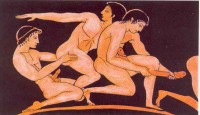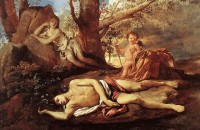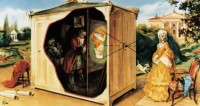Dana Amir: Cleft Tongue: The Language of Psychic Structures
“The scene of perversion is a scene of seduction. In this scene, which is shared, whether consciously or not, by two people, there is a continuous continuous reversal of roles in which the chosen object, the person on which the perverse subject actually depends and with whom he yearns to fuse, turns from being the one in power into the one who is led, unbeknownst to him and sometimes against his own will, into the perverse labyrinth. Whence does the perverse seduction take its power? How does the perverse subject go about the seduction scene? What allows him or her to recognise precisely the other’s needs, and what enables him or her to so smoothly penetrate that other? The perverse subject’s accurate identification of the other’s needs is not a true identification ...Read More
Jamieson Webster & Nuar Alsadir in conversation with Barry Yourgrau for the launch of “Mess”
“The word “hoard” derives from the proto-Germanic term for “hidden or secret treasure.” Hoards are well known to archeologists, dating back over 10,000 years to the hunter-gatherers of the Stone Age. Foodstuffs such as joints of meat were common early deposits, ditto ornaments, weapons, and human remains— all buried for safekeeping and intended for retrieval. The hoards of the later Bronze and Iron Ages got more elaborate: sumptuous weapons (lots of axes), tools, jewelry, coins. Votive hoards, or ritual offerings, though, were interred permanently. Often in watery areas, and after being rendered useless, I noticed: many broken swords flung into rivers. I couldn’t help think of myself destroying my old bowl before sending it down the garbage chute. But here was the thing: those caches of ba...Read More
Dany Nobus: Writing as an Instrument of Torture – An Exploration of Sade’s Practical Reason via Lacan’s “Kant with Sade”
Of the twenty-eight substantial papers and six shorter contributions that make up Lacan’s Écrits, “Kant with Sade” is generally regarded as one of the toughest nuts to crack, and this opinion is shared by some of the most eminent and knowledgeable commentators on Lacan’s work. In this seminar, I will unpack one of the crucial lines of Lacan’s argument in “Kant with Sade”, notably that the contents of Sade’s libertine novels, which he also designated as “the Sadean fantasy”, i.e. the fantasy Sade articulated as a literary text within the space of his creative imagination, cannot be mapped directly onto the author’s life. Although it is the ‘sadistic’ fantasy of Sade’s libertine heroes that tends to dominate within the Sadean fantasy—whose full spectrum also includes the more ‘masochistic’ s...Read More
Josh Cohen: Art, Psychoanalysis, Art and the Logic of Indifference
“As Leo Bersani and others have observed, there is a paradox at the heart of the Freudian corpus that animates and finally undoes it. In resisting the theoretical innovation of the death drive, Freud’s contemporaries were resisting an inner tendency of psychoanalysis to corrode the capacity of any stable concept to contain and master the forces it discloses. It’s with a certain poignancy of understatement that Freud describes the existence of masochism, in his 1925 essay on the subject, as a ‘problem’ from an economic point of view. ‘Eco – nomos’, the law of the home, the even flow and distribution of energy, is ruined at a stroke by masochism, the psycho-sexual preference for pain over pleasure, for the heightened agitation rather than contented homeostasis of the organism. But as J...Read More
Angelo Villa: Hystericization and Psychoanalytic Belonging
“For belonging does entail an identification; I suggest that the turning point must be made through the difference between a passive identification and an active one. As far as the analysis delves into a familial bond, it allows the patient to return and find a new place in his personal history; a different place from where he had been placed by his symptom, along with those symptoms belonging to others. In other words, the analysis doesn’t break the belonging (how would it be possible?) but it allows the patient to introduce into it his own subjectivity, to have the chance to finally re-write his belonging. This is what needs to happen in an association, too. Belonging to an association should entail the possibility of affecting the life of the association. This is the only way towa...Read More
Patricia Gherovici: Attack of the Difficult Ecrits – Class 2 – The Situation of Psychoanalysis
This class was based on a collaborative annotated reading by Patricia Gherovici and Manya Steinkoler of Lacan’s “The Situation of Psychoanalysis and the Training of Psychoanalysts in 1956,” to be published in the forthcoming Reading the Écrits – A Guide to Lacan’s Works, edited by Derek Hook, Calum Neill, and Stijn Vanheule. The following is an excerpt from this forthcoming volume, posted here with permission from the editors: Psychoanalytic Fable In the essay, fittingly vituperative, Lacan will now adopt an absurdist tone in what will take the form of an extended fable emulating moralist philosopher Jean de la Bruyere (1645-1696)’s satires inspired by Theophrastus (371-287 BC). Both authors are dear to Lacan, and the French comic tradition. Lacan describes the pitfalls of the bureau...Read More
Jamieson Webster: Attack of the Difficult Ecrits – Class I – Variations on the Standard Treatment
A poetic rendition by Cecilia Wu If we follow Jamieson’s lead and focus on the writing itself, considering the fact that Lacan’s writings are unsweetened, condensed transcripts of his speech acts, it’s hard to dismiss his mode of attack as a pain in the ass, or as unruly hunks of raw hide to be adorned with the transferential ornaments of infantile hate. Lacan himself counsels against merely reproducing the crossfire of attack and counterattack, serially recapitulating a civil war of transference that exiles the enemy while clinging to the hope that it will all come out in the wash. The clash of minor differences runs through an opinionator equalizer akin to the trifling ‘intermediary discourse’ Lacan wishes to silence, the chatter that enforces homeostasis as...Read More
Gerard Pommier: What Did Feminism and Gender Studies Bring to Psychoanalysis?
In his presentation to Das Unbehagen, Gerard Pommier addressed the challenge of defining the term ‘Woman’: “The uncertainty is such that this difficulty of definition could be used itself as a definition and normative ideal! Judith Butler writes, for instance, that “if a subject unique to feminism remains to be constructed, it would be even more realistic to abandon such a project,” since, she explains, “the category ‘women’ can only reach some stability and coherence within the heterosexual matrix…” Nothing shows this difficulty better than the fragmentation of the feminist movement, or the opposition to feminism by a large number of women. Some theoreticians maintain that gender is a relationship, and not an individual attribute. Others, like Simone de Beauvoir, attest ...Read More
Somatic Experiments, Clinical Encounters: In the Consulting Room with “Testo Junkie” – Paul B. Preciado in conversation with Kirsten Lentz, Carolyn Stack and Jamieson Webster
This interdisciplinary forum on Testo Junkie: Sex, Drugs, and Biopolitics in the Pharmacopornographic Era, puts author Paul B. Preciado into conversation with clinicians — Kirsten Lentz, Carolyn Stack, and Jamieson Webster, along with moderator Muriel Dimen — to discuss the range of ways Preciado’s genre-bending account of gendered embodiment both challenges and expands psychoanalytic accounts of gender, desire, and somatic experience. And vice versa. This forum continues a multi-year joint initiative between CSGS and the journal Studies in Gender and Sexuality to promote open-ended exchanges between cultural theory and psychoanalytic theory. Co-sponsored by the NYU Center for the Study of Gender & Sexuality, the NYU Department of Performance Studies, and Studies in Gender and Sexual...Read More
Sergio Benvenuto: Perversions are not Paraphilias
“Many deny, of course, that perversions exist, even if the dominant psychiatry has re-baptized them as “paraphilias.” A name change attributable to political correctness, considering that the term “pervert” is today an insult. In Greek, paraphilia means “wrong love”. After all, it’s better to insult a pervert in Ancient Greek than in Modern English. Some note that we call perverse those sexual acts we don’t consider “normal.” But the criteria for sexual normality has varied from one era to another, and today even more quickly. And then, the picture is complicated by the fact that many perversions—such as masochism, urophilia or fetishism—have no criminal implications, while others lead to very serious incriminations. So we cannot reduce perversions to simply illegal sexual activities...Read More
Adele Tutter: Under the Mirror of the Sleeping Water – Poussin’s Narcissus
Nicholas Poussin’s four paintings on the theme of Narcissus and Echo, completed over the course of three decades, reflect a deepening appreciation of their source in Ovid’s Metamorphoses. Poussin’s interpretations of the Narcissus myth parallel critical junctures in the development of psychoanalytic theories of narcissism, including those of Freud, Andreas-Salome, and Rosenfeld. The analysis of Poussin’s evolving vision supports a radical reappraisal of the enigmatic myth at the heart of psychoanalytic theory and practices, and the disturbances named after it. Click here to listen to audio Click here to read Adele Tutter’s “Under the mirror of the sleeping water: Poussin’s Narcissus” published in the International Journal of Psychoanalysis, 2014 Cecilia Wu’s C...Read More
Elissa Marder: Knock Knock: Femininity, Fixation, Photography
“Ultimately, what I am seeking in the photograph taken of me (the ‘intention’ according to which I look at it) is Death: Death is the eidos of that Photograph. Hence, strangely, the only thing that I tolerate, that I like, that is familiar to me, when I am photographed, is the sound of the camera. For me, the Photographer’s organ is not his eye (which terrifies me) but his finger: what is linked to the trigger of the lens, to the metallic shifting of the plates (when the camera still has such things). I love these mechanical sounds in an almost voluptuous way, as if, in the Photograph, they were the very thing -and the only thing -to which my desire clings, their abrupt click breaking through the mortiferous layer of the Pose. For me the noise of Time is not sad: I love bells, clocks...Read More























